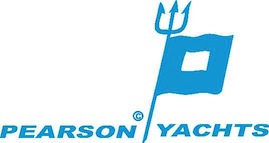Related Research Articles
The Pearson Triton, sometimes referred to as a Triton 28, is an American sailboat that was designed by Carl Alberg as a racer-cruiser and first built in 1958. It was introduced at the 1959 National Boat Show in New York City and was one of the first fiberglass boat designs built. The design also launched Alberg's career as a naval architect.

Bristol Yachts was an American company which was among the first commercially successful production fiberglass sailboat boat builders. The company was founded in 1964 and closed in 1997.

The Pearson Renegade is a 27' sloop rigged sailboat produced by Pearson Yachts of Bristol, RI from 1966-1969, with the first boats being sold in 1967. Designed by William Shaw, about 175 of the boats were built. They were Pearson's first split underbody boat and were designed to Cruising Club of America racing rules. They are also one of the first American "racer-cruiser" style boats that combine the comforts of a cruising boat with the advantage of a modified full keel with a spade rudder, like that of the Bill Lapworth Cal 40 designs that revolutionized ocean racing in the mid-late 1960s. The keel allows the boat to track well and have good stability. The deep balanced rudder allows a high degree of maneuverability, and the turning radius of the boat is very tight. It continues to be a sought after boat because of their stout construction and kindly sailing ability.
Carl Alberg was a Swedish born naval architect known for his influence in early fiberglass boats.

Cape Dory Yachts was a Massachusetts-based builder of fiberglass sailboats, powerboats, and pleasure trawlers which operated from 1963 to 1992. It also produced a small number of commercial craft.
The Alberg 35 is a fiberglass sailboat designed by Carl Alberg. It is also known as the Pearson Alberg 35. The design was produced not only by Pearson Yachts in Rhode Island, but also by AeroMarine Composites and Ericson Yachts. It is the larger cousin of the Alberg 30 and the Pearson Triton. The Alberg 35 was the second yacht put into production by Pearson after the hugely successful Triton. In the case of Ericson, boats were produced from Pearson molds that had been salvaged by Ericson employees from a California landfill; the Alberg 35 became one of Ericson's early successes.

The Pearson Ensign is an American sailboat that was designed by Carl Alberg as a one-design racer and day sailer and first built in 1962. It is the largest full-keel one-design keelboat class in the United States.
The WoodPussy is a 13½’ catboat designed by Philip Rhodes. The first boats were constructed in 1945 by Palmer Scott Boat Works. These boats were wood with wooden masts. The class switched to fiberglass hulls in the early 1960s. It is estimated that 800-850 hulls were constructed by Palmer Scott, MarScott and O'Day.

The Universal Atomic 4 is a four-cylinder, gasoline engine produced by the Universal Motor Company between 1949 and 1984 for use as auxiliary power on sailboats. Both 18 horsepower (13 kW) and 30 horsepower (22 kW) versions of the engine were produced. Over 40,000 of the engines were produced during that time, with an estimated 20,000 still in use today.

Pearson Yachts was a sailboat manufacturer founded by Everett Pearson and Clinton Pearson in 1956. One of the first fiberglass sailboat manufacturers, they grew rapidly during the 60s and 70s, while also developing and designing new boats. However, the company changed ownership throughout the 1980s, after which the company filed for bankruptcy, and was eventually sold to Grumman Allied Industries in 1991. The rights to the name are now held by the Pearson Marine Group.

John Gale Alden (1884–1962) was an American naval architect and the founder of Alden Designs.
The Triton 22 is an American sailboat, that was designed by Gary Mull and first built in 1985. The design is out of production.

The Capri 22 is an American trailerable sailboat, that was designed by Gary Mull and Frank Butler and first built in 1984.
The Triton 25, also called the Pearson 25, is an American sailboat, that was designed by Gary Mull and first built in 1984. The design is out of production.

The C&C Redwing 30, also called the C&C 30 Redwing, Redwing 30 or just the Redwing, is a Canadian sailboat, that was designed by Cuthbertson & Cassian and first built in 1967.

The Alberg 22 is a Canadian sailboat, that was designed by Swedish naval architect Carl Alberg and first built in 1970.

The Nonsuch 22 is a Canadian trailerable sailboat, the smallest of the series of Nonsuch sailboats. It was designed by Mark Ellis Design and first built in 1984.
The Pearson Electra is an American sailboat that was designed by Carl Alberg for a Midget Ocean Racing Club (MORC) racing and first built in 1960.
The Cape Dory 22 is an American sailboat that was designed by Carl Alberg as a cruiser and first built in 1981.
The Corinthian 19, also called the Bristol 19, is an American trailerable sailboat that was designed by Carl Alberg as a cruiser and first built in 1966.
References
- "The Lure of Sailing"; Everett Pearson, New York Harper & Row c1965
- "John G. Alden and His Yacht Designs"; Robert W. Carrick & Richard Henderson, McGraw Hill, 1983.
- [note: Carrick & Henderson's book contains several references to Alberg's work at Alden including on page 409 his drawing for the lines of the Hinckley 21, a 28.5' sloop that bears a striking resemblance to his later work on both the Pearson Triton and Pearson Ariel]